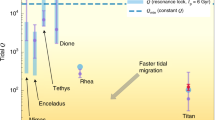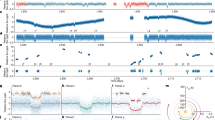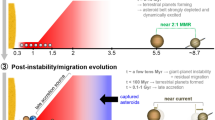Abstract
Kinoshita and Nakai1 have recently performed the longest numerical integration of the outer bodies of the Solar System ever attempted. The positions and velocities of Jupiter, Saturn, Uranus, Neptune and Pluto for the 5 Myr that they computed extended the integration time by a factor 5 with respect to previous ephemerides computed by Cohen et al.2. Although this is only one-thousandth of the present age of the Solar System, our analysis of the data using new methods3–5, shows surprising dynamical features. Stability is monitored by separating the system into three-body subsystems. It is found that the outer Solar System is made up of two main subsystems, Sun–Jupiter–Saturn and Sun–Uranus–Neptune, exchanging angular momentum over a period of 1.1 Myr. The dynamical mechanism responsible for locking the two subsystems together is a libration of the angle between Jupiter's and Uranus' perihelion around 180° with the same period of 1.1 Myr. No dynamical locking over such a long period of time has been found in the Solar System, although similar mechanisms have been predicted.
This is a preview of subscription content, access via your institution
Access options
Subscribe to this journal
Receive 51 print issues and online access
$199.00 per year
only $3.90 per issue
Buy this article
- Purchase on Springer Link
- Instant access to full article PDF
Prices may be subject to local taxes which are calculated during checkout
Similar content being viewed by others
References
Kinoshita, K. & Nakai, H. Celest. Mech. (submitted).
Cohen, C. J., Hubbard, E. C. & Oesterwinter, C. Astr. Pap. Am. Ephem. 22, part 1 (1973).
Milani, A. & Nobili, A. M. Celest. Mech. 31, 213–240 (1983).
Milani, A. & Nobili, A. M. Celest. Mech. 31, 241–291 (1983).
Milani, A. & Nobili, A. M. in Proc. int. Symp. G. Lemaitre, (Reidel, Dordrecht, in the press).
Astronomical Almanac (HMNAO of Royal Greenwich Observatory and NAO of USNO, London–Washington, 1984).
Marchal, C. Astr. Astrophys. 10, 278–289 (1971).
Smale, S. Invent. Math. 11, 45–64 (1970).
Easton, R. J. Diff. Equat. 19, 258–269 (1975).
Szebehely, V. & Zare, K. Astr. Astrophys. 58, 145–152 (1977).
Roy, A. E. in Applications of Modern Dynamics to Celestial Mechanics and Astrodynamics (ed. Szebehely, V.) 103–130 (Reidel, Dordrecht, 1982).
Milani, A. & Nobili, A. M. Celest. Mech. (submitted).
Author information
Authors and Affiliations
Rights and permissions
About this article
Cite this article
Milani, A., Nobili, A. Resonance locking between Jupiter and Uranus. Nature 310, 753–755 (1984). https://doi.org/10.1038/310753a0
Received:
Accepted:
Issue Date:
DOI: https://doi.org/10.1038/310753a0
This article is cited by
-
Celestial mechanics: Testing Solar System stability
Nature (1986)
-
Long-term changes in the semimajor axes of the outer planets
Nature (1986)
Comments
By submitting a comment you agree to abide by our Terms and Community Guidelines. If you find something abusive or that does not comply with our terms or guidelines please flag it as inappropriate.



